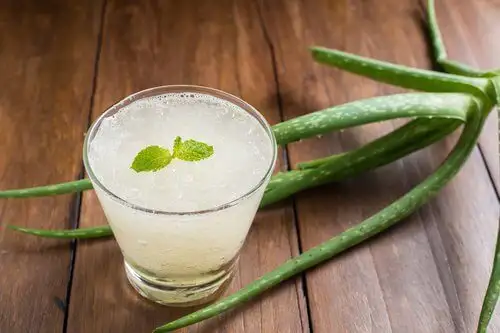Aloe Vera is an African plant, commonly as known as the queen of medicinal plants, which comes from Asphodelaceae family.
At the moment, world of biology and botany knows for 250 species of certain plant. 4 of them have very useful medical use and the most known Aloe Vera species is exactly the one we are going to talk about in this article.
The history of this Aloe Vera is great, and it starts years ago when botanist Miller went to Barbarossa Island to explore and research it. Through his adventures and work on the mentioned Island, he found Aloe Vera.
The full name of the plant is Aloe Vera Barbadensis Miller and as you can guess, incredible plant was named after the scientist who found it and after the place (island) in which it was found. Nicknames of the Aloe are also plant of immortality, plant of life and the elixir of youth.
This is a relatively short, herbaceous plant that grows about 80-100 cm in height. So called queen of plant has sabre-shaped, spiky leaves with serrated edges that resemble a rose growing out of the ground. From the center of the rose grows a flower stalk that ends in yellow or reddish flowers.
It is one of the oldest plants and the juice from the plant leaf contains over 240 nutritional and medical ingredients. Doctors and scientist pronounced it to be the most useful plant for medical (healing) usage.
Aloe Vera Barbadensis Miller contains:
-12 vitamins from different vitamin complexes (A, C, E, B1, B2, B3, B6, B12) which are extremely hard to find in other plants.
– Folic acid (also very hard to find)
– 20 minerals (calcium, phosphorus, potassium, sodium, iron, chromium, copper, zinc, selenium…)
– 19 out of 20 amino acids (of which 7 out of 8 essential ones are not produced by the body and must be subsequently ingested).
– Enzymes (16 enzymes from the group of proteases, amylases, lipases and cellulases)
– Anthraquinines, lignins, saponins, sterols.
All of those mentioned supplements make Aloe Vera the most complete and the healthies medical plant in the flora of the planet Earth.
Aloe Vera process of growing a plant
The Aloe Vera plant is grown in areas with a subtropical climate. Ideal growing conditions are in countries such as the Dominican Republic and Arizona in the USA. Despite this, you can grow the plant wherever you are but you must dedicate your time and space to adjusting it for the plant.
Aloe Vera can be grown in pots, which should be kept on the sunny south or east side of the window, because it is the size of the plant and the amount of aloin in the leaves that is proportional to the amount of light the plant need to receive.
Aloin is the most important ingredient in Aloe Vera and has a very strong effect on intestinal bacteria. It breaks them down, activates and improves intestinal muscle contraction.
Older plants prefer the sun, while young plants prefer the shade. After winter, the plant should be taken out of the closed space, but it should not be exposed to direct sunlight immediately, because the leaves will turn yellow, so it should first be placed in partial shade.
On the other hand, you can also grow Aloe Vera in plantations.
The process of planting Aloe Vera
Aloe Vera has a shallow root (20 cm – 30 cm), so it should be planted in a wider and shallower pot. It is best to put a layer of stones and then a layer of sand on the bottom of the pot for growing aloe, and only then add soil. Containers must be one-fourth filled with drainage material and compost, as such a planting system is the closest to its natural environment.
The ideal temperature for growing Aloe Vera indoors is 20ºC to 24ºC during the day and around 10ºC to 14ºC at night. Given that there is as much as 95% water in the leaves of the mentioned plant, due to the danger of freezing, the temperature must never fall below 5ºC.
If you bring it indoors in the winter, don’t bring it in a living room, rather in a hall or some colder space, where it will spend the winter comfortably.
Aloe Vera nutrition
In the spring, it is fed with fertilizers rich in phosphorus and flowering is encouraged during June. Aloe Vera should be fertilized during the growth period by mixing the soil with gravel and 30% compost. Many lovers and growers of aloe add humus from oak leaves to the soil with pebbles and thereby improve its growth.
Propagation of Aloe Vera
The simplest way of propagating Aloe Vera is to plant saplings, by carefully separating the shoot from the bottom or the bud, and planting it. The mother plant “drives” saplings already in the second year of growth. They can be transplanted when they grow 2.5 cm to 5 cm. The best time is in May and June, during the period of the most intensive growth and development of the plant.
In addition to propagation from saplings, it can also be propagated by leaf cuttings, which is also the most common method of propagation of this species. It is enough to separate the leaves from part of the stem with garden shears and plant them. The rooting process takes at least a month.
Life span of Aloe Vera and harvest method
For the end of the article, let’s explain harvest method.
Average lifespan of Aloe Vera is 12 years, but after four years they reach maturity and are ready to be harvested. You should harvest them every 6 – 8 weeks, by removing the 3 – 4 last leaves of the plant. The leaves are cut at the base, so by the time of processing, the total amount of gel remains in the leaf. The leaves must be handled gently to prevent damage to the outer bark and to prevent the entry of bacteria at the base of the leaf.




